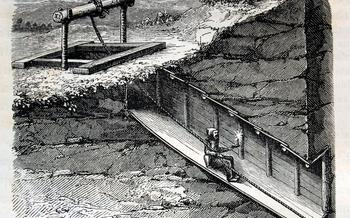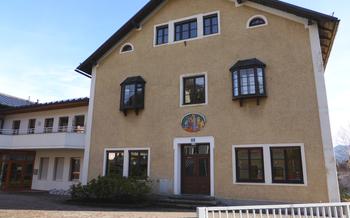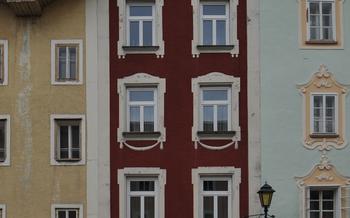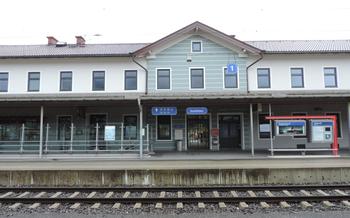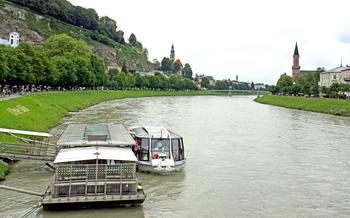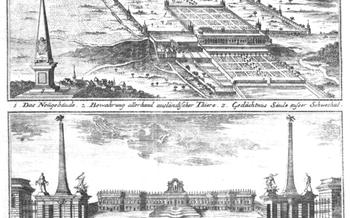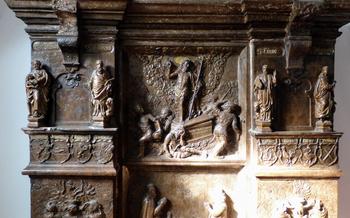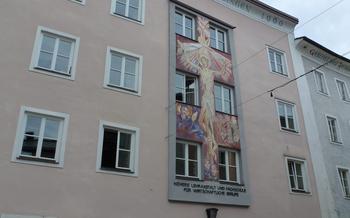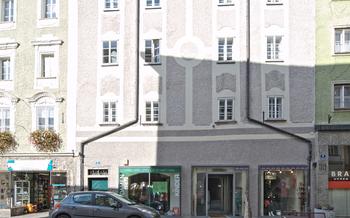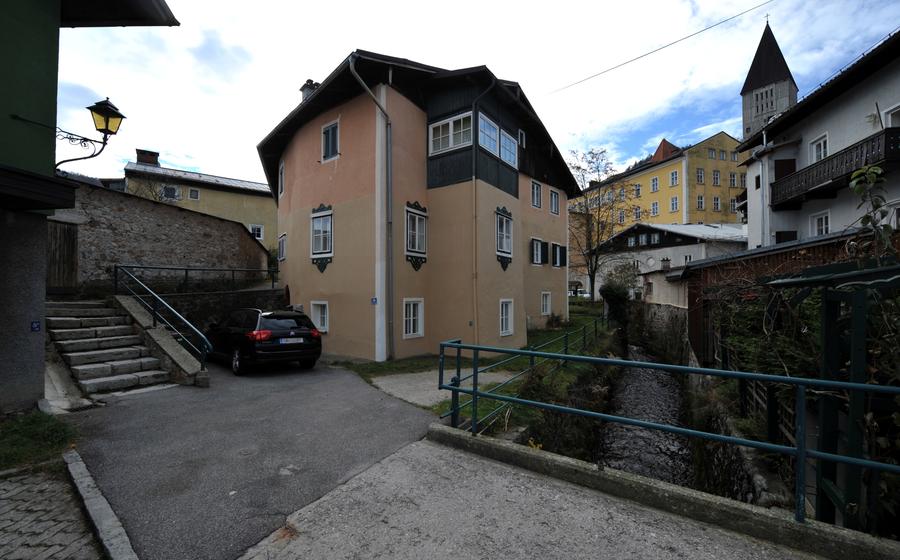
Kapuzinerberg and Capuchin Monastery
- Hallein and its Salt Mines
- Kapuzinerberg: A Haven of Natural Beauty and Stunning Views
- Local Legend: The Guardian of Kapuzinerberg
- Capuchin Monastery:
- Pilgrimage Route
- Ossuary:
- Museum im Berg:
- Celtic Village:
- Keltendorf Salina: A Journey Through Celtic History and Culture
- Exhibits and Artifacts
- Reconstructed Celtic Village
- Celtic Salt House and Workshop
- Anecdote: An Unexpected Discovery
- Halleiner Spielzeugmuseum: A Journey Through Time and Play
- Silent Night Museum: A Journey into the Heart of a Beloved Carol
- Hallein Food and Drink
- Insider Tip
Hallein and its Salt Mines
Hallein, a picturesque town nestled in the Austrian Alps, boasts a rich history intertwined with salt production. Since the Middle Ages, Hallein's salt mines have been a vital source of wealth and prosperity for the region. The town's strategic location at the foot of the Dürrnberg mountain, where vast deposits of salt were discovered, transformed it into a significant trading hub. Hallein's salt mines not only shaped its economy but also played a crucial role in shaping the cultural identity of the region.
In the early days of salt mining, the conditions were harsh, and the work was physically demanding. Miners faced numerous challenges, including the risk of cave-ins, flooding, and the constant threat of respiratory problems caused by the salt dust. Despite these hardships, the miners persevered, driven by the allure of the "white gold" that lay beneath the mountain. Their relentless efforts and ingenuity paved the way for the development of innovative mining techniques that would revolutionize the industry.
Kapuzinerberg: A Haven of Natural Beauty and Stunning Views
Nestled amidst the picturesque landscapes of Hallein, Kapuzinerberg stands as a beacon of natural splendor and breathtaking vistas. This majestic mountain, shrouded in an aura of tranquility, offers visitors a sanctuary from the bustling city below. Ascend its verdant slopes and be rewarded with panoramic views that stretch far and wide, encompassing the snow-capped peaks of the Alps, the meandering Salzach River, and the charming town of Hallein itself.
Kapuzinerberg's unique geographical location, rising abruptly from the valley floor, provides a vantage point unlike any other. From its summit, visitors can witness the sun casting its golden rays across the surrounding countryside, painting a breathtaking tapestry of light and shadow. The mountain's elevation also affords a unique perspective on Hallein's rich history, with the town's landmarks and monuments laid out before you like a miniature model.
In addition to its stunning views, Kapuzinerberg is home to a diverse array of flora and fauna. The mountain's slopes are adorned with a vibrant tapestry of wildflowers, their colors shifting with the seasons. Keen-eyed visitors may spot rare and endangered species, such as the Alpine ibex, chamois, and marmots, roaming freely among the mountain's rocky outcrops. The air is alive with the sound of birdsong, as numerous species, including golden eagles, falcons, and hawks, soar overhead.
Local Legend: The Guardian of Kapuzinerberg
Legends and folklore are deeply intertwined with the history of Kapuzinerberg. One tale, passed down through generations, speaks of a benevolent spirit that watches over the mountain and its inhabitants. According to legend, a wise old man, known as the Guardian of Kapuzinerberg, resides in a hidden cave deep within the mountain's heart. He is said to possess extraordinary powers and is revered by the local people as a protector and guide.
The Guardian is believed to emerge from his secluded abode only in times of great need, offering counsel and assistance to those who seek his wisdom. It is said that those who venture onto Kapuzinerberg with pure intentions and a respectful heart may encounter the Guardian and receive his blessings. Whether fact or fiction, the legend of the Guardian adds a touch of enchantment to the already mystical aura of Kapuzinerberg.
Capuchin Monastery:
Hallein's Capuchin Monastery, nestled on the slopes of Kapuzinerberg, is a testament to the town's rich religious heritage. Founded in 1583 by Capuchin monks, the monastery has stood as a beacon of faith and spirituality for centuries. Its striking architecture, featuring a simple yet elegant church, reflects the humility and devotion of the Capuchin Order.
Inside the monastery, visitors can admire the intricate frescoes adorning the walls and ceilings, depicting scenes from the life of St. Francis of Assisi, the founder of the Capuchin Order. The church's altarpiece, a masterpiece of Baroque art, is a sight to behold, showcasing the skill and artistry of the period.
Beyond its architectural beauty, the Capuchin Monastery has played a significant role in the religious and cultural life of Hallein. The monks have been instrumental in providing spiritual guidance and support to the local community, fostering a deep sense of faith and devotion. The monastery has also served as a center for education and learning, with the monks establishing a school to educate the town's children.
One of the most fascinating figures associated with the Capuchin Monastery is Father Johannes Capistran, a renowned preacher and miracle worker who lived in the monastery during the 15th century. Father Capistran's eloquent sermons and miraculous healings attracted vast crowds, making him a legendary figure in Hallein's history.
Pilgrimage Route
Kapuzinerberg has a long history as a pilgrimage site, attracting devout individuals seeking spiritual renewal and connection with the divine. The pilgrimage route, known as the "Stations of the Cross," is a central feature of this tradition. It consists of a series of 14 stations, each representing a significant event in the final hours of Jesus Christ's life.
These stations are marked by intricately carved wooden crosses and sculptures, inviting pilgrims to pause, reflect, and pray as they follow the path up the mountainside. Each station depicts a scene from Jesus' journey to Calvary, from his condemnation and scourging to his crucifixion and resurrection.
As pilgrims make their way along the route, they are immersed in a contemplative atmosphere, surrounded by the natural beauty of the mountain and the poignant symbolism of the Stations of the Cross. The pilgrimage becomes a deeply personal and moving experience, allowing individuals to connect with their faith and seek spiritual growth.
Anecdote: One pilgrim, Maria, described her experience on the pilgrimage route as transformative. As she ascended the mountain, she felt a sense of peace and serenity wash over her. Each station provided an opportunity for reflection and prayer, allowing her to deepen her understanding of Jesus' sacrifice. By the time she reached the summit, she felt a renewed sense of purpose and a strengthened connection to her faith.
Ossuary:
Within the Capuchin Monastery, a somber yet intriguing reminder of mortality awaits visitors - the ossuary. This dimly lit chamber houses a collection of skulls and bones, carefully arranged in decorative patterns that transform the remains into a haunting work of art. The ossuary serves as a powerful symbol of the transience of life, reminding visitors of the inevitable fate that awaits us all.
One particular skull, adorned with a crown of dried flowers, stands out amidst the others. According to local legend, it belonged to a young woman who was engaged to be married but died tragically on the eve of her wedding. Her fiancé, heartbroken and unable to bear the thought of living without her, took his own life and was buried alongside his beloved.
Visitors to the ossuary are often struck by a sense of awe and contemplation. The meticulously arranged bones and skulls, each representing a life once lived, serve as a poignant reminder of the fragility of human existence. The ossuary invites visitors to reflect on their own mortality and to appreciate the preciousness of life.
Museum im Berg:
Deep within the heart of Hallein's salt mines lies a hidden gem: the Museum im Berg. This interactive museum offers a fascinating glimpse into the history and traditions of salt mining in the region. Through engaging exhibits and displays, visitors can learn about the techniques and tools used by miners throughout the centuries.
The museum's centerpiece is a series of life-size dioramas that depict various aspects of the mining process, from the extraction of salt to its transportation and storage. Visitors can also watch demonstrations of traditional salt mining techniques, such as drilling and blasting, and experience the unique atmosphere of the underground chambers.
One of the most memorable exhibits at the Museum im Berg is a replica of a miner's slide. These slides were used by miners to transport salt and other materials quickly and efficiently through the narrow tunnels. Visitors can try their hand at sliding down a replica of the slide, providing a thrilling and unforgettable experience.
Anecdote:
During my visit to the Museum im Berg, I had the opportunity to try my hand at the miner's slide. Despite my initial hesitation, I couldn't resist the temptation to experience this unique attraction. As I slid down the narrow chute, I couldn't help but imagine what it must have been like for the miners who used these slides daily to transport heavy loads of salt. It was a thrilling and exhilarating experience that gave me a newfound appreciation for the challenges faced by these hard-working individuals.
Celtic Village:
Nestled amidst the picturesque landscapes surrounding Hallein, the Celtic Village offers a captivating glimpse into the past. This meticulously reconstructed settlement transports visitors to the era of the Celts, an ancient civilization that once thrived in this region. Step into the village and immerse yourself in the vibrant Celtic culture, brought to life through interactive exhibits and captivating storytelling.
Discover the intricate details of Celtic life as you explore recreated dwellings, workshops, and communal spaces. Learn about their traditional crafts, such as pottery, weaving, and metalworking, and marvel at the ingenuity and artistry of these ancient people. Experience the thrill of archery, try your hand at Celtic crafts, and engage in hands-on activities that bring history to life.
This immersive journey through time is a delight for visitors of all ages. Families can embark on an educational adventure together, while history enthusiasts can delve deeper into the fascinating Celtic heritage of the region. The Celtic Village serves as a vibrant reminder of the rich cultural tapestry that has shaped Hallein and its surroundings.
Anecdote:
In the heart of the Celtic Village, a family of four embarked on a captivating journey through time. The children's eyes sparkled with excitement as they dressed in traditional Celtic attire and learned about the customs and traditions of this ancient civilization. They marveled at the intricate designs of the pottery and eagerly tried their hand at weaving on a simple loom. As the afternoon sun cast golden rays across the village, the family gathered around a crackling fire, listening intently to a storyteller narrate tales of Celtic legends and bravery. It was an unforgettable experience that transported them back to a time when the spirit of the Celts roamed freely amidst these very hills.
Keltendorf Salina: A Journey Through Celtic History and Culture
Keltendorf Salina, nestled in the heart of Hallein, offers a captivating glimpse into the rich history and traditions of the Celts. This unique museum transports visitors back in time, showcasing the fascinating world of these ancient people who once inhabited the region.
Exhibits and Artifacts
The museum houses an impressive collection of artifacts and exhibits that bring Celtic culture to life. Visitors can marvel at intricate jewelry, pottery, tools, and weapons, each telling a story of Celtic craftsmanship and ingenuity. Interactive displays and multimedia presentations further enhance the experience, providing insights into Celtic beliefs, customs, and way of life.
Reconstructed Celtic Village
A highlight of the museum is the meticulously reconstructed Celtic village. This immersive exhibit allows visitors to step into the shoes of the Celts, exploring a replica of their homes, workshops, and communal spaces. Here, they can witness demonstrations of traditional Celtic crafts, such as metalworking, weaving, and pottery, gaining a deeper appreciation for the skills and knowledge of these ancient artisans.
Celtic Salt House and Workshop
Keltendorf Salina also features a reconstructed Celtic salt house and workshop, paying homage to the region's deep connection to salt production. Visitors can learn about the techniques used by the Celts to extract and process salt, a precious commodity that played a vital role in their economy and culture.
Anecdote: An Unexpected Discovery
During a visit to Keltendorf Salina, a group of researchers stumbled upon a remarkable discovery. While examining a collection of artifacts, they noticed an unassuming pendant that had been overlooked for years. Upon closer inspection, they realized that the pendant was made of a rare and precious metal, indicating that it may have belonged to a high-ranking Celtic chieftain or priestess. This unexpected find shed new light on the wealth and status of the Celts who once called this region home.
Halleiner Spielzeugmuseum: A Journey Through Time and Play
The Halleiner Spielzeugmuseum, or Toy Museum, is a treasure trove of toys from different eras and cultures. Located in the heart of Hallein, this enchanting museum takes visitors on a journey through the history of play and imagination. The extensive collection features dolls, teddy bears, board games, and mechanical toys, each with its own unique story to tell. Interactive exhibits and play areas invite children of all ages to engage with the toys and discover the magic of play.
One captivating anecdote recounts the experience of a young girl named Emma, who was fascinated by the museum's doll collection. As she gazed upon the delicate porcelain faces and intricately detailed costumes, she felt as if she had stepped into a world of enchantment. Emma spent hours admiring the dolls, imagining their adventures and creating her own stories. The museum's collection sparked her creativity and left an enduring impression on her childhood.
Silent Night Museum: A Journey into the Heart of a Beloved Carol
Nestled in the heart of Hallein, the Silent Night Museum invites visitors to embark on a heartwarming journey through the origins and global impact of the beloved Christmas carol, "Silent Night." Interactive exhibits, guided tours, and captivating concerts showcase the song's enduring legacy, making it a must-visit destination for music enthusiasts and those seeking a deeper connection to this iconic melody.
One visitor, Maria, was particularly moved by her experience at the museum. As she strolled through the exhibits, she felt a sense of awe and wonder as she learned about the history of the carol, its humble beginnings in a small Austrian village, and its subsequent journey to become a global phenomenon. The guided tour brought to life the stories behind the song's creation, the challenges faced by its composers, and the heartwarming anecdotes that have become part of its rich tapestry.
The museum's collection of artifacts, including original manuscripts, musical instruments, and personal belongings of the carol's creators, provided Maria with a tangible connection to the past. She marveled at the simplicity and elegance of the melody, and the profound impact it has had on people around the world. The museum's interactive exhibits allowed her to immerse herself in the music, listening to different interpretations and arrangements, and even trying her hand at conducting a virtual choir.
As Maria left the Silent Night Museum, she carried with her a newfound appreciation for the song's power to transcend language, culture, and time. The museum had not only provided her with a deeper understanding of the carol's history, but had also touched her heart and left her with a lasting sense of joy and inspiration.
Hallein Food and Drink
Hallein's culinary scene is as diverse and inviting as the city itself. From traditional Austrian dishes to local delicacies, there's something to satisfy every palate. Indulge in hearty Tafelspitz, a boiled beef dish served with horseradish sauce, or savor the flavors of Wiener Schnitzel, a classic breaded cutlet. Don't miss the chance to try Kasnocken, a regional specialty featuring cheese-filled dumplings with crispy onions.
For a truly authentic experience, head to Gasthof zur Post, a charming restaurant housed in a 16th-century building. Here, you can feast on traditional Austrian dishes prepared with fresh, local ingredients. For a more modern take on Austrian cuisine, visit the stylish Restaurant Esszimmer, where innovative dishes are presented with flair.
When it comes to drinks, Hallein offers a variety of options to quench your thirst. Sip on a refreshing Gösser beer, produced in the nearby town of Göss, or sample the local wines from the surrounding vineyards. For a sweet treat, try the Mozartkugel, a chocolate ball filled with pistachio marzipan, created in nearby Salzburg.
Insider tip: For a unique culinary experience, join a food tour that takes you to hidden gems and introduces you to Hallein's culinary delights. From traditional taverns to modern bistros, you'll get a taste of the city's diverse cuisine and learn about its rich culinary history.
Insider Tip
For an unforgettable experience, venture off the beaten path to discover Hallein's hidden gems. One such gem is the lesser-known viewpoint at the edge of the forest, offering breathtaking panoramic vistas of the city and the majestic mountains that embrace it. Capture the essence of Hallein in a single frame as you witness the sun casting its golden rays across the landscape, painting a picture of tranquility and beauty.
When hunger strikes, seek out the inconspicuous Gasthof zur Post, nestled amidst the charming cobbled streets of the old town. This family-run gem serves authentic Austrian cuisine that will tantalize your taste buds. Savor the flavors of traditional dishes prepared with fresh, local ingredients, accompanied by a glass of crisp regional wine.
As a memento of your Hallein adventure, consider bringing back a unique souvenir that reflects the city's rich heritage. Visit the Halleiner Heimatmuseum, a treasure trove of local history and culture. Here, you can find handmade crafts, traditional costumes, and historical artifacts that tell the story of Hallein's past.
Finally, let serendipity guide your exploration of Hallein. Take the time to wander aimlessly through the picturesque streets, allowing your curiosity to lead you to unexpected discoveries. You might stumble upon a hidden courtyard, a charming art gallery, or a friendly local who shares fascinating stories about their beloved city. Embrace the unplanned moments, and you'll be rewarded with memories that will last a lifetime.
